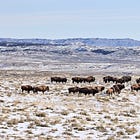Bring on the nanosponges! Tackling toxic mining waste as trade wars heat up
As electric vehicles, batteries and solar cells use more rare earth minerals, the resulting toxic sludge can't be ignored. Plus, hopeful headlines for bison, snowy owls, cows, fish, forests & oysters.
Nano what?
That’s right, companies are using tiny filters called nanosponges to clean up wastewater from mining, The New York Times reports. New technologies that include specialized membranes, ion exchange filters and even tightly woven plastic bags are capturing tons of lithium, magnesium and rare earth minerals from toxic mining sludge.
The U.S.-China trade war has placed these substances in the spotlight, since China holds a firm grip on their supply. Filtering wastewater boosts domestic supply of high-demand minerals while ameliorating the pollution that is the inevitable byproduct of any mining activity.1
From the NYT’s “A Toxic Pit Could Be a Gold Mine for Rare-Earth Elements”:
While methods to remove metals from water have been around a long time, in recent years the global scramble for metals critical to manufacturing and technology advances has given birth to a new generation of extraction technologies and processes. …
“We’re turning a giant liability into something that’s contributing to defense,” said Mark Thompson, vice president for environmental affairs at Montana Resources. “There’s some high-level metallurgy going on here. Real egghead stuff.”
Rare earth elements, because of their magnetic properties, are used in defense systems like drones and fighter jets but also in cell phones and all carbon-reducing technologies like electric cars, solar panels, windmills and batteries.
China produces 60 percent of rare earths and processes 90 percent. Now, there’s a renewed push to produce and process more of these in America.
Advocates for clean energy face a moral dilemma, since mining, no matter how we slice it, is never clean. The toxic sludge that emanates from any type of mine — whether gold for wedding rings or lithium for the batteries that power electric cars — is deadly and must be managed for generations after profits are tallied. Even with environmental laws that are strict by global standards, metal mining is America’s number one toxic polluter.2 Imagine what’s happening in China, where environmental protections are far more lax.
Even ore mined in the United States is sent to China for processing, where fewer regulations make it cheaper and more feasible to do so, but no less harmful to people and the planet.3
The Mountain Pass Mine in California, the only one in the country dedicated to rare earths, produces 15 percent of global supply.
wrote about the mine several months ago”:California's stringent regulatory framework, designed to prioritize environmental protections, has made domestic processing particularly challenging. Across the rare earths industry, this dependence on Chinese facilities exposes a significant vulnerability in the rare earth supply chain, leaving the United States and other countries reliant on foreign infrastructure to produce critical materials essential for technologies such as electric vehicles and advanced military systems.
China dominates production not just of rare earths, but also the batteries for which such elements are needed, including those in electric vehicles. Though Trump vowed to increase manufacturing in the U.S., the latest iteration of his budget bill eliminates loans for three large electric vehicle battery factories in red states. Economist
concluded4 that Trump “is intentionally forfeiting the technological future to China.”I’ll agree and add: Any reader of this newsletter knows I support clean energy, but we’ve got to stop this planetary NIMBYism. Part of the reason climate-fighting technology is so cheap is that rich countries have exported the pollution costs to China and other less prosperous nations. We must continue to innovate to keep down these environmental costs, which can last for generations, wherever the mining and processing take place.
Bring on the nanosponges!

Hopeful Headlines
As China burns less coal, prices spiral down
Though China is building out clean energy at a record pace, it’s still the largest coal burner on the planet. However, last month, its coal plants ran at 80 percent capacity, which left prices in a downward spiral. Bloomberg ran this ominous headline last week: Glut of coal locks market in vicious cycle of decline. Meanwhile, Reuters reported the drop in China’s power generation could be a result of factory slowdowns from trade tensions and warmer weather. The trend leaves China on track for a decline in fossil fuel electricity generation in 2025.

Malaysia: Citizen “fish hunter squad” nets tons of invasive catfish
Aquarium catfish have invaded Malaysia’s rivers, consuming eggs and fry of native species. While in COVID lockdown, a healthcare consultant turned angler discovered just how many suckermouths he could catch. When he posted his exploits on social media, his following grew to over 1,000 fans, many of whom have joined the effort in person.
“People kept asking how to join our group, because we were looking at the ecosystem,” Haziq said. …
Focusing first on Malaysia’s Selangor state and rivers in the capital Kuala Lumpur, the fish hunter squad had netted nearly 31 tonnes of suckermouths by 2024. They have also visited rivers in other states in Malaysia as their campaign expands.

Kyrgyzstan unveils 8,000-square-kilometer ecological corridor for biodiversity
The Kyrgyz Republic has created its largest protected area to allow snow leopards and their prey, Asiatic ibex, room to roam. The new 8,000-square-kilometer (3,000-square-mile) protected area isn’t home to any permanent human settlements, just a whole lot of grazing sheep.
From the UN Environment Program:
Previously, over 65,000 sheep grazed in the corridor area during summer months. With the corridor's introduction, grazing planning and the rotation of livestock herds will be adapted to reduce this figure by 15,000, leaving mountain pastures more time to recover and providing grazing opportunities for wildlife. The redistribution process, coordinated with local herders and community leaders, aims to protect livelihoods while environmental goals are met.

Oysters rebound in Maine and Chesapeake Bay; Irish study finds they’re great for the environment
Wild oysters are returning to Maine waters, while beds in Chesapeake Bay further south have tripled in the past 20 years. Meanwhile, Anthropocene Magazine reports oysters are darn good for water quality and climate:
New research from Ireland adds to the mounting evidence that bivalve aquaculture can provide benefits for climate and nutrition. The recent study finds that Irish oyster farms remove 228% more nutrients than they produce, provide coastal cleanup to the value of $2 million, and lock away tons of carbon in their shells.
Yum.
Oklahoma keeps cows out of creeks, watches water quality improve
From The New York Times:
Today, Horse Creek is no longer on the state’s list of most contaminated waterways. And, thanks to practices such as the ones enacted by Mr. Victor, about 100 Oklahoman streams once polluted by runoff predominantly from farmland have been restored to health. That’s more than in any other state, according to the Environmental Protection Agency.
“The amazing thing that I have to keep telling people is, ‘You can’t believe how quickly it all changed,’” Mr. Victor said. “Mother Nature knows how to heal itself. It always has and always will, but you have to give it a chance.”
Detroit plants a giant sequoia forest? Why not?
“If I’m going to plant a tree, why would I plant one that lives only 50 years? Why not plant one that lives 1,000 years?” says Birch Kemp of Arboretum Detroit. Volunteers recently planted several dozen sequoia trees on an abandoned lot, part of an effort to make the city more livable.
What this article from Moss & Fog doesn’t mention is that redwoods, including giant sequoias, once thrived across North America, Europe & Asia, including Michigan, during the age of dinosaurs. They’re just returning home to Detroit.
Colorado state and Wyoming tribes say bison are ‘wild’
There’s no animal more “wild” than bison in America, but most states do not legally classify them as such. Rather, bison are most often considered cattle, and many hundreds of thousands are raised on farms to supply a broad market for buffalo burgers.
Now, Colorado has taken the small step of classifying wild-roaming bison as wild. While Colorado isn’t home to any wild bison herds, its neighbor Utah does have three wild herds, and a few individuals occasionally wander across the state line. Colorado’s new law protects these bison; they cannot be killed without a hunting permit.
Native American tribes are also starting to reclassify bison. Last month, the Eastern Shoshone in Wyoming made them “wildlife” again, and the Northern Arapahoe are expected to follow suit, reports The Associated Press:
[Jason] Baldes argues buffalo should be able to roam on the plains to bolster biodiversity and restore ecological health of the landscape — but that has to come with a change in relationship.
“Buffalo as wildlife allows the animals to exist on the landscape,” Baldes said. “Rather than livestock based on economic and Western paradigms.”
I’ve written about bison on American Prairie lands in Montana here:
How prescribed burns are reshaping Southern Oregon forests and communities
From Oregon Public Broadcasting:
In fire-prone Southern Oregon, residents of the Green Springs joined forces to carry out a 12-acre prescribed burn — lighting controlled fire to reduce wildfire risk and restore forest health. The effort reflects a growing movement to use “good fire” to reshape landscapes and build community resilience.
South Africa: Controlled burns in Kruger National Park are based on 70 years of research
From Utah Public Radio:
“If we weren’t to have fires, maybe a savanna would turn into a very wooded, forested area. If we were to have too many fires, maybe it would become a lot more grass dominated — or barren," said Strydom. "So having the right fire regime for certain landscapes is important.”
Beneficial fire and thinning prevent old-growth devastation in California
Last week, I spoke with MacArthur genius grant recipient and fire historian Stephen Pyne about thinning old-growth forests, a practice some have labeled “logging,” to the detriment of wildfire prevention.
“We are in a fire age, and it’s maturing,” Pyne said. “It’s quickened and acquired more intensity. We are remaking the world; we are making a fire age. You already feel it, even if you don’t see flames or breathe the smoke. The places that are burned are not going to come back the way they used to. We have a no-analogue future. Take all the features of an ice age, mass extinctions, ecological change, and you pass it through a kind of pyric looking glass, and that’s the age we’re living through.”
California: Native turtles return to Yosemite after removal of invasive bullfrogs
Turtles were 2 to 100 times more abundant where bullfrogs were absent. Not until bullfrogs were nearly eradicated from the sites in 2019 did scientists observe the first juvenile turtles at the formerly "bullfrog-present" ponds.
I’m a bit of a Yosemite addict, if you can’t tell. Please see my story about the Sierra High Country’s native frogs returning after fish were removed:
Boston: Snowy owl savior relocates 900 birds over 40 years
When officials at Boston’s Logan Airport began shooting snowy owls for airplane safety decades ago, Norman Smith could not stand by and do nothing. For over 43 years, he’s been trapping and relocating snowy owls who migrate to the airport from the Arctic every winter.
“I just hope that when my grandkids and their grandkids grow up, that snowy owls will still be around so they get a chance to see them and appreciate them as I have,” Smith says in this incredibly inspiring video:
About Earth Hope:
Earth Hope is a solutions-based journalism project that highlights environmental success stories to inspire action. I’m Amanda Royal, a former newspaper reporter and current eco-news junkie. Read more about this project and what inspired it.
Visit earthhope.substack.com for more stories. Heads up: I’m taking a break from my writing and editing services for the summer.

Could it also relieve pressure to open new mines?
Before guilt about the toxic legacy of renewable energy brings us to the point of hopelessness, remember that the waste generated from coal mining and oil drilling is 50 times larger per unit of energy than that created by solar power.
Soon to be true for copper from Kenya as well.
Noah Smith sums up the political and economic reverberations of the rare earths trade pinch here. In an argument that isn’t new among economists, he compares the United States with China in the 14th century, when the Ming Dynasty refused to engage with the outside world, believing it had acquired all the technology it would ever need. Though it was the most advanced civilization on the planet at the time, the Ming Dynasty famously destroyed its navy because it feared free trade.









Excellent post. Fascinating and well researched. Well written, per usual. Thanks for the mention!
Your hopeful headlines are such a heartening reminder of the fact that not all environmental news stories have to be deflating.